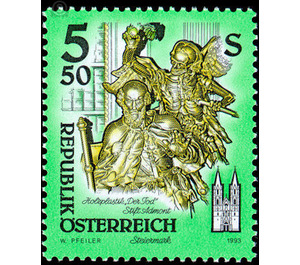Works of art from monasteries - Austria / II. Republic of Austria 1993 - 5.50 Shilling
Theme: Art & Culture
| Country | Austria / II. Republic of Austria |
| Issue Date | 1993 |
| Face Value | 5.50 |
| Color | yellow green |
| Printing Type | combination printing |
| Stamp Type | Definitive |
| Item Type | Stamp |
| Chronological Issue Number | 1437 |
| Chronological Chapter | OOS-OE2 |
| SID | 889761 |
| In 91 Wishlists | |
A few kilometers before the entry of the Enns in the wild and romantic Gesäuse amidst a magnificent mountain landscape, the market town of Admont with the eponymous Benedictine Abbey, the oldest existing monastery in Styria. The founding of Admont Abbey dates back to Archbishop Gebhard of Salzburg, who on 29 September 1074 inaugurated the first monastery church in honor of the martyr bishop Blasius. Throughout the centuries, the monastery developed into a place of cultural and scientific maintenance and also enjoyed a rapid economic boom. A fire on April 27, 1865, which spread throughout the village, destroyed most of the abbey building. In 1939 the monastery was confiscated by the rulers of the Third Reich and repealed as an "anti-state and anti-state institution". It was not until 1945 that the convent was able to return to the monastery and begin work.


